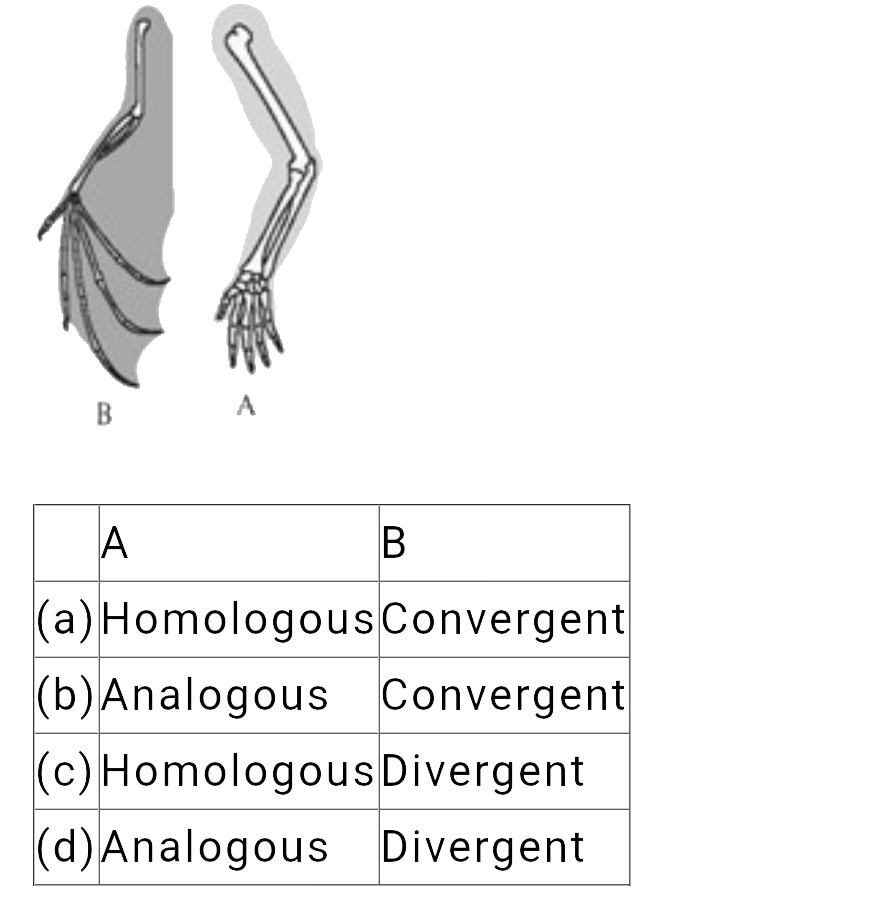[A]: Convergent evolution leads to production of analogous similarities among different groups of organisms.
[R]: Animals of the same group or closely related groups exhibit great divergences in their morphologySolution in Kannada
If both A and R are true and R is the correct explanation of A
If both A and R are true but R is not the correct explanation of A
If A is true and R is false
If both A and R are false
The correct Answer is:B
Step by step video solution for [A]: Convergent evolution leads to production of analogous similarities among different groups of organisms. [R]: Animals of the same group or closely related groups exhibit great divergences in their morphology by Biology experts to help you in doubts & scoring excellent marks in Class 12 exams.
Updated on:21/07/2023Topper's Solved these Questions
Similar Questions
[A] : Endomycorrhiza of forest trees contribute to the efficient nutrient cycling in tropical test ecosystems .
[R] : The fungi that form endomycorrhizal association with plants store nutrient ions and make them available to the host plants .
View SolutionGive reason for -
(i) Both strands of DNA are not copied during transcription.
(ii) Transcription and translation in bacteria can be coupled.
View SolutionA group of individual organisms with fundamental morphological similarities is called?
View Solution[A]: Convergent evolution leads to pro_duct1on of analogous similarities among different groups of organisms.
[R]: Animals of the same grou~ or closely r~- lated groups exhibit great divergences in their morphology
View SolutionA and B are examples of ………………i………… organs and represent ………..ii…………… evolution .

AB(a)HomologousConvergent(b)AnalogousConvergent(c)HomologousDivergent(d)AnalogousDivergent
View SolutionAnalogous organs suggest divergent evolution.
View SolutionThe organisms that exhibit the characters of two different groups are
View SolutionWhat are the analogous organs or convergent evolution?
View Solution[A]: Convergent evolution leads to pro_duct1on of analogous similarities among different groups of organisms. [R]: Animals of the same grou~ or closely r~- lated groups exhibit great divergences in their morphology
View Solution[A]: During evolution of Primates, various groups diverged in a particular sequence from the main line of descent. [R]: Prosimians (Tarsiers, lemurs) which diverged first, are most distantly related to humans and most closely related to original primates.
View Solution[A]: Macro evolution produces groups of parallel special adaptations among convergent but related species. [R]: Adaptive radiation/macroevolution don't produce evolutionary lines that converge in special adaptation with other related groups differing in general adaptation
View SolutionEvidences OF Organic Evolution || Evidences From Comparative Morphology and Anatomy || Homology ( Divergent Evolution+ Adaptive Radiation) || Analogy (Convergent Evolution + Adaptive Convergence)
View SolutionCompare and contrast divergent and convergent evolution :
Which of the following would result in a group of species that are physiclly similar but NOT genetically related?
View Solution[A]: During evolution of Primates, various groups diverged in a particular sequence from the main line of descent.
[R]: Prosimians (Tarsiers, lemurs) which diverged first, are most distantly related to humans and most closely related to original primates.
View Solution[A]: Macro evolution produces groups of parallel special adaptations among convergent but related species.
[R]: Adaptive radiation/macroevolution don't produce evolutionary lines that converge in special adaptation with other related groups differing in general adaptation
View Solution
